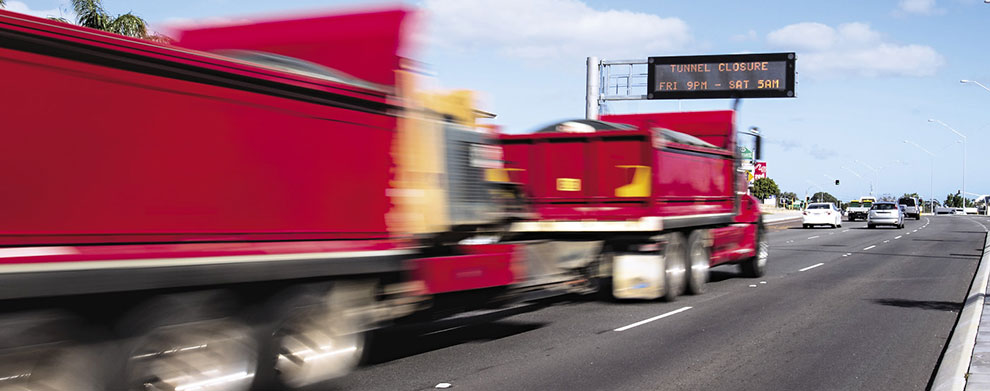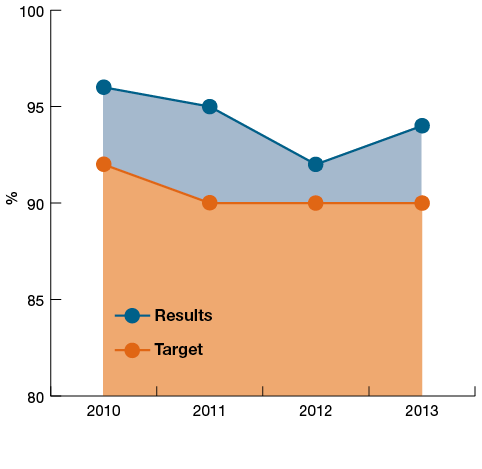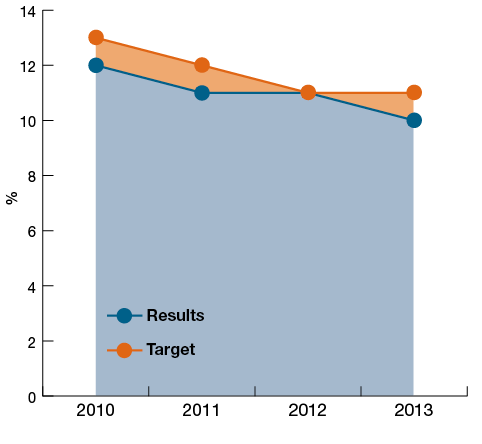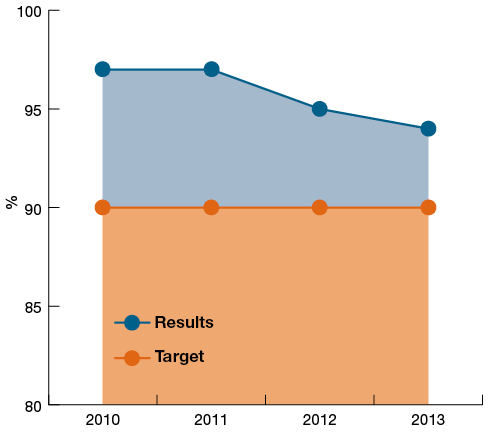
Key Performance Measures
Introduction
Main Roads uses performance measurement to gain insight into, and make judgements about, the effectiveness and efficiency of its programs, processes and people. We measure our progress in meeting strategic goals and outcomes, gather and analyse performance data and then use that data to drive improvements and successfully measure the deployment of actions into outcomes.
Our performance measures support managerial decision making by providing useful information regarding how efficient and effective our core processes are, if improvements are necessary, to identify potential risk areas, determine if our customers and stakeholders are satisfied and if we are meeting our own and the Government’s goals.
We have a well-established outcome based performance measurement framework that seeks to measure the organisation’s success in terms of delivering on agreed Government goals and outcomes. Our performance measures are integrated within the monthly performance evaluation process undertaken by the Corporate Executive Leadership team.
Alignment with Government Goals
The Western Australian Government has identified the following goals that Main Roads will contribute to in delivering its stated goals. We achieve the delivery of the Government goals through an outcome based Program Management approach. There are seven programs that drive outcome based decision making to achieve agreed business outcomes. The following table shows the alignment of each Program against the Government’s goals.
Main Roads |
Government |
|
Program |
Outcome |
Goal |
Road Safety |
A safe road environment |
Outcome Based Service Delivery |
Office of Road Safety |
Improved coordination and community awareness of road safety |
|
Road Management |
Reliable and efficient movement of people and goods |
|
Road Efficiency |
||
State Development |
Facilitate economic and regional development |
State Building – Major Projects |
Maintenance |
A well maintained road network |
Stronger focus on the Regions |
Community Access |
Improved community access and roadside amenity |
Social and Environmental Responsibility |
Changes since the last report
During the year Main Roads carried out a minor review of its measures seeking to adopt a number of recommendations identified in the Auditor General’s report to Parliament “Beyond Compliance: reporting and Managing KPIs in the Public Sector” and to formalise a number of other amendments including minor changes to improve methodology and moving reporting of the Smooth Travel exposure form annual to biennial. These changes have been reported in the commentary accompanying as they have been adopted. The Deputy Under Treasurer formally approved these various minor amendments in January 2013.
Understanding Community Perception Measures
Four of the measures are derived from an annual Community Perceptions Survey that seeks to reflect the satisfaction levels of customers in both metropolitan and rural areas of the State. These results are used to ensure that Main Roads’ projects and customer service initiatives are targeted at the areas of greatest need.
Through the use of an external research company, the data was collected by way of telephone interview using a developed structured questionnaire. The results are based upon a random sample of 1 101 people (201 persons in the Metropolitan area and 900 persons in rural areas – 100 from each Main Roads Region). When extending these results to estimate the percentage of satisfied Western Australians, the margin of error is approximately 2.9% at the 95% confidence level and is also weighted to reflect the actual population distribution based on ABS statistics.
Please notethat the structure of the survey questionnaire has changed in 2011-12 however, the questions used to derive the results for this indicator remain unchanged. As such comparability with prior year results is not affected.
The four measures are Community Satisfaction with Main Roads, road safety, maintenance and provision of cycleway and pedestrian facilities.
Understanding On Time and On Cost Measures
The delivery of infrastructure in a State that is as climatically and geologically diverse as Western Australia provides many challenges. Ten of our efficiency measures are based on reporting against the delivery of our contracts in terms of time and cost. To recognise the complexity in achieving this, and consistent with approaches taken in other road agencies, all reporting against these measures includes a 10% margin when calculating the final outcome.
Structure
The following provides a summary of Main Roads’ program outcomes and measures for each indicator showing the trend over time as well as providing a status report as to how the results for 2012-13 compared against the targets agreed with Government. The remainder of this chapter provides commentary on the efficiency and effectiveness indicators grouped around the seven outcome based programs.
Summary of Key Performance Measures and Outcomes
2010 |
2011 |
2012 |
2013 Target |
2013 Actual |
||||
Road Safety Program |
||||||||
% Community Satisfaction of road safety |
96 |
95 |
92 |
90 |
94 |
|||
Black Spot location indicator |
11.7 |
11.2 |
10.7 |
11 |
10.3 |
|||
% of contracts completed on time |
59 |
61 |
67 |
90 |
70 |
|||
% of contracts completed on budget |
95 |
88 |
95 |
90 |
95 |
|||
Office of Road Safety Program |
||||||||
% Effectiveness of road safety awareness campaigns |
84 |
79 |
60 |
>50 |
83 |
|||
% of ORS Projects completed on time |
78 |
90 |
87 |
90 |
78 |
|||
% of ORS Projects completed on budget |
82 |
88 |
97 |
90 |
100 |
|||
Road Efficiency and Road System Management Programs |
||||||||
% Community Satisfaction |
97 |
97 |
95 |
90 |
94 |
|||
Road network permitted for use by heavy vehicles |
B Double – 27.5m % |
99 |
96 |
96 |
96 |
97 |
||
Double RT – 27.5m % |
98 |
96 |
96 |
96 |
97 |
|||
Double RT – 36.5m % |
79 |
78 |
78 |
78 |
79 |
|||
Triple RT – 53.5m % |
44 |
44 |
44 |
44 |
44 |
|||
% Network configuration |
Roads |
89 |
89 |
89 |
90 |
89 |
||
Bridges |
Strength |
n/a |
n/a |
87 |
87 |
88 |
||
Width |
94 |
94 |
95 |
94 |
95 |
|||
% of contracts completed on time |
44 |
57 |
55 |
90 |
86 |
|||
% of contracts completed on budget |
89 |
86 |
82 |
90 |
100 |
|||
Average $ cost of network management per million vehicle km travelled |
4,300 |
3,840 |
3,853 |
3,743 |
4,535 |
|||
State Development Program |
||||||||
Average return on construction expenditure |
2.0 |
2.7 |
2.1 |
2.5 |
3.1 |
|||
% of contracts completed on time |
40 |
71 |
33 |
90 |
100 |
|||
% of contracts completed on budget |
100 |
100 |
100 |
90 |
100 |
|||
Road Maintenance Program |
||||||||
% Smooth Travel Exposure |
98 |
98 |
n/a |
97 |
97 |
|||
% Community Satisfaction road maintenance |
93 |
94 |
90 |
90 |
84 |
|||
% Preventative maintenance indicator |
87 |
88 |
86 |
85 |
87 |
|||
% availability of traffic signals, road lighting and emergency phones |
Traffic Signals |
99.1 |
99.1 |
99.4 |
99 |
n/a |
||
Road Lighting |
99.4 |
97.4 |
96.1 |
99 |
n/a |
|||
Emergency phones |
99.9 |
99.9 |
99.9 |
99 |
n/a |
|||
Average $ cost of network maintenance per lane kilometre of road network |
6,183 |
6,083 |
7,939 |
7,400 |
7,926 |
|||
Community Access Program |
||||||||
% of the year that 100% of the Main Roads’ State road network is available |
96 |
85 |
90 |
70 |
94 |
|||
% Community satisfaction with cycleways and pedestrian facilities |
90 |
90 |
76 |
90 |
83 |
|||
% of contracts completed on time |
86 |
50 |
80 |
90 |
80 |
|||
% of contracts completed on budget |
71 |
100 |
100 |
90 |
80 |
|||

Great Eastern Highway Widening
Road Safety
Outcome: Providing a Safe Road Environment
This program seeks to reduce the State’s road fatality rate to the lowest in Australia by minimising road factors contributing to road trauma and reducing the serious crash injury rate. We demonstrate this through the following measures:
Effectiveness Indictors
Community Satisfaction with Road Safety
This indicator represents how satisfied the community is with Main Roads’ overall performance in the area of road safety. The survey results show that Main Roads’ high performance on road safety remains strong rising a further two points since last year to achieve 94% of survey participants rating it as okay or better exceeding the target of 90%.

Black Spot Location Indicator
The indicator gives a measure of the number of locations on the road network that meet State Black Spot criteria based on an analysis of crash history.
The measure uses a sliding window to determine whether the number of locations eligible for funding is increasing or decreasing, taking into account the amount of travel in the State and the annual Black Spot funding used to treat those locations. Last year the results for the period 2008 to 2011 were recast to incorporate new information made available by the Australian Bureau of Statistics that amends the vehicle kilometres travelled input. Including this revised information ensures that the results over time remain accurate and comparable. The four year trend continues to shows a gradual decline in the number of eligible black spot locations with the current result being the lowest recorded since the implementation of the Black Spot program in 2001, coming in below the estimated target.

Efficiency Indictors
Percentage of Contracts Completed on Time
This indicator represents the percentage of contracts that were delivered on time in the Road Safety Program. Whilst the target was established at 90%, 70% of contracts were delivered on time which is an improvement on the previous year. Of the contracts that were late 10 exceeded the target date by more than 10 days. The following is an explanation of the reasons in each case:
- Two contracts were delayed due to inclement weather combined with increases in scope delaying completion of works
- One due to inclement weather causing some rework
- One due to additional works being undertaken
- One due to delays in service relocations
- Five are currently works in progress arising from factors that include increase in scope of works, inclement weather, delays in procuring materials, service relocations and availability of a line marking contractor.
Percentage of Contracts Completed on Budget
This indicator represents the percentage of contracts delivered on budget in the Road Safety Program. The result of 95% reflects an improvement on the previous year. There were two contracts that exceeded their target value both due to additional works being taken.
Office of Road Safety
Outcome: Improved Coordination and Community Awareness of Road Safety
This program represents the outcomes sought from the Office of Road Safety and their role in supporting the Minister for Road Safety and the Road Safety Council in coordinating and raising community awareness of the road safety effort for Western Australia. We demonstrate this through the following measures:
Effectiveness Indictors
Effectiveness of Road Safety Awareness Campaigns
This indicator represents the portion of Western Australian drivers who remember seeing major road safety community education campaigns (valued at more than $500 000) conducted by the Office of Road Safety.
The data is collected independently through a professional market research company by conducting campaign evaluation surveys of in excess of 400 responses before and after each major campaign, with a margin of error at plus or minus 5 per cent at the 95 per cent confidence level. This year the data is based on six major campaigns which averaged a penetration rate of 83% which exceeds the target of achieving an audience penetration rate of 50% or greater.
Efficiency Indictors
Percentage of Projects Completed on Time
This indicator represents the percentage of projects approved by the Road Safety Council and the Minister for Road Safety that were delivered on time by the Office of Road Safety, it excludes external bodies grant funded projects. The current year’s result shows that 78% of all projects were delivered on time which is below the target of 90%, there was no single cause as to why four of the projects were delivered late. Reasons for the late delivery include impacts of caretaker mode during the election, drafting of legislation taking longer than anticipated, delays in evaluation and award of a tender for publishing crash statistics and reworking of a business case associated with the development of an enhanced road safety information system.
Percentage of Contracts Completed on Budget
This indicator represents the percentage of projects approved by the Road Safety Council and the Minister for Road Safety that were delivered on budget by the Office of Road Safety. The current year’s result shows that 100% of all projects were delivered on cost ahead of the target of 90%.
Efficiency and Road System Management
Outcome: Safe and Efficient Movement of People and Goods
The Efficiency Program seeks to improve the efficiency, capacity and utilisation of the existing road network whilst the Road System Management Program seeks to optimise real-time management of the network, provide traveller information, asset management planning and to support service delivery throughout the organisation. Together these programs contribute to achieving the outcome.
We demonstrate this through the following measures:
Effectiveness Indictors
Community Satisfaction
The Community Satisfaction Indicator represents how satisfied the community is with Main Roads’ overall performance in the management and operation of the State road network. The results are drawn from the Community Perception Survey where respondents were asked to rate Main Roads’ overall performance on a five-point scale, 94% of respondents rate Main Roads’ performance as okay or better. The overall trend remains positive with very strong results over the past four years exceeding the established target.

Road Network Permitted for use by Heavy Freight Vehicles
This indicator relates to the efficient movement of goods within Western Australia and the percentage of available State roads accessed by B-Doubles, Double road trains and Triple road trains. The use of larger vehicles with greater payloads can increase the overall efficiency of freight transport operations, resulting in lower transport costs. However, to maintain road safety and guard against infrastructure damage, restrictions are placed on some trucks. Because of the relatively high efficiency of these vehicles, the proportion of roads accessible to them is an important factor in the overall efficiency of freight transport in this State. Over the past four years the trend has remained relatively consistent with most minor fluctuations in results attributed to changes in ownership of roads between State and Local Government and very minor variations with access categorisation.
Network Configuration-Roads
This indicator shows the percentage of travel undertaken on roads meeting specific criteria for seal width, carriageway width and curve rating. The indicator gives a measure of the ability of Main Roads to plan for and maintain roads to desirable standards. In 2013, 89.4% of travel was undertaken on roads meeting the seal width, carriageway width and curve rating criteria which was very close to the target of 90%. The results over the four-year period are relatively consistent and demonstrate that Main Roads continues to plan and program works to address roads that are below the criteria.
Network Configuration – Bridges
Similar to the roads measure, bridges are assessed for strength and width using agreed investigatory criteria. The monitoring of bridge strength and width needs to ensure a safe and efficient road network relating to improved access and transport efficiencies. These measures are indicators for the number of bridges that meet, or are above, the investigatory criteria, recorded as a percentage of the total number of bridges on main roads and highways. Therefore, the percentage of bridges meeting these network configuration criteria should continue to rise but only slightly in future years. All bridges that do not meet the investigatory criteria for strength or width are considered in assessing, scoping and prioritising works, as part of the ten year bridge strategy.
Strength – The results of this indicator show that 88% of the bridges meet the agreed criteria for strength against a target of 87%. It should be noted that this year’s results reflects the adoption of an approach that compares the strength rating of a bridge based on its strategic role within the road network and its ability to meet that role. This new approach ensures that the information we are reporting against is representative of the actual vehicles requesting access to the bridge and therefore better reflects the use of the asset. It is not possible to report results prior to 2011-12.
Width – In relation to width 95% of bridges meet the criteria against a target of 94% which is consistent with previous years.
Efficiency Indictors
Percentage of Contracts Completed on Time
This indicator represents the percentage of contracts that were delivered on time in the Road Efficiency Program. Whilst the target was established at 90%, 86% of contracts were delivered on time which is a significant improvement on last year. Of the three contracts that were late only one exceeded the target date by more than 10 days. In that instance the scope of works was increased to include an additional pedestrian bridge.
Percentage of Contracts Completed on Budget
This indicator represents the percentage of contracts delivered on budget in the Road Efficiency Program. The result achieved was 100% of contracts being delivered on budget.
Average Cost of Network Management
This indicator measures the financial efficiency of the Road System Management program in terms of cost per million vehicle kilometres travelled to manage the road system. In order to compare current figures with previous years all figures have been adjusted and reported in terms of current year’s dollars. The overall four year trend is inconsistent as this program includes occasional one-off development costs that can affect the overall results. In respect of the current year the result of $4,535 per million vehicle kilometres travelled (mvkt) exceeds the target. The target was established using an estimate of mvkt, now that the actual figures are available it is apparent that the estimate used to establish the target was overstated.
State Development
Outcome: Facilitating Economic and Regional Development
This program expands the road network in accordance with State and Commonwealth transport and land use strategies that will facilitate the economic and regional development of the State. We demonstrate this through the following measures:
Effectiveness Indictors
Return on Construction Expenditure
New road and bridge construction networks add to the capacity of the road network. Return on Construction Expenditure is based on Benefit Cost Ratio (BCR) estimates of a set of projects undertaken each year. It indicates the extent to which road and bridge construction expenditure will deliver future economic benefits to the community. This indicator represents the expenditure weighted BCR for the State Development Program and Road Efficiency program for which a BCR has been calculated. The result of 3.1 exceeds the target of 2.5.
Efficiency Indictors
Percentage of Contracts Completed on Time
This indicator represents the percentage of contracts that were delivered on time in the State Development Program. The result achieved was 100% of contracts being delivered on time which is an improvement on last years result.
Percentage of Contracts Completed on Budget
This indicator represents the percentage of contracts delivered on budget against a target of 90% in the State Development Program. The result achieved was 100% of contracts being delivered on budget which is consistent with last year’s result.
Road Maintenance
Outcome: Providing a Well Maintained Road Network
This program seeks to maintain the existing road and bridge network by maximising asset life and minimising whole of life costs. We demonstrate this through the following measures:
Effectiveness Indictors
Smooth Travel Exposure
This indicator is based on the percentage of travel undertaken on the State road network meeting specific roughness criteria. In 2011 the decision was made to only capture the information used in reporting this data on a biennial basis meaning that this is the first results since the 2010-11 financial year. The result of 97% is consistent with previous years and reflects that the majority of all travel is undertaken on roads that meet the roughness standard.
Efficiency Indictors
Community Satisfaction of Road Maintenance
The Community Satisfaction of road maintenance indicator represents how satisfied the community is with Main Roads in the maintenance of the State road network. The results are drawn from the Community Perception Survey. Overall community satisfaction with road maintenance has declined to 84% over the last year against a target of 90%. The survey showed that people in Perth are happier with the maintenance of road surfaces, compared to those in the Gascoyne, Wheatbelt North, Wheatbelt South and Goldfields-Esperance Regions. Responses indicate that one of the primary areas of concern is in relation to “loose gravel and rough surfaces”.
Preventative Maintenance Indicator
The Preventative Maintenance Indicator provides a measure of the proportion of sealed state road network which has a surfacing age younger than its optimal target age. The indicator provides a measure of proactive maintenance undertaken on the network on an annual basis. Sections of the network with a surfacing age younger than target age are classified as ‘Good’. In 2013, the proportion of the network with a surfacing age considered ‘Good’ is 86.7% which is above the target value of 85%. It should be noted that as a result of additional data being available for previous years the results for 2011 and 2012 are slightly higher than reported previously. Overall the results for the four-year period remain consistent.

Availability of Traffic Signals, Road Lighting and Emergency Telephones
Since 2008 Main Roads has been measuring the availability of traffic signals, road lighting and emergency telephones throughout the road network as a percentage of time the assets are fully operational. The measures were reportable outcomes sought under the Traffic Control Infrastructure Contract or TCIC. In March of this year the TCIC expired and services were subsumed within Main Roads Integrated Service Arrangements. Data validity issues arose during this change in process and as a consequence Main Roads will not be reporting on these indicators as part of the annual performance measures.
Average Cost of Network Maintenance per Lane Kilometre of Road Network
This indicator identifies the financial efficiency of road and roadside maintenance works by showing the cost per lane kilometre to maintain acceptable travel conditions on the State roads. In determining the cost basis expenditure on structures and infrastructure depreciation has been excluded. In order to compare current figures with previous years all figures have been adjusted and reported in terms of current year’s dollars which can influence the trend result. The overall trend for this measure remains inconsistent with the current result indicating that the measure came in above target by $526. The reason for this is largely as a result of excessive unforseen expenditure arising from declared Natural Disasters.

Perth Arena, Wellington Street
Community Access
Outcome: Improving Community Access and Roadside Amenity
This program seeks to provide infrastructure that will increase personal mobility and community access. We demonstrate this through the following measures:
Effectiveness Indictors
Unplanned Road Closure on the State Road Network
Generally 100% of Main Roads Road network is available to all road users; however, there are unplanned road closures due to a number of reasons including flooding, cyclones, major bushfires and major road accidents, which may vary in duration. The availability of the sealed road network is measured as a percentage of calendar days that the whole network is available to the road user. Closure is determined by measuring the number of whole days (24 hours commencing from the time the road is closed) that any section of the sealed road network is closed. This year the road network was available 94% of the year which exceeds the 70% target. All closures were due to flooding and rainfall events including Tropical Cyclone Rusty.
Community Satisfaction with Cycleways and Pedestrian Facilities
This indicator represents how satisfied the community is with Main Roads’ performance in the construction, maintenance and management of cycleways and pedestrian facilities. The results are drawn from the Community Perception Survey. The overall result shows that community satisfaction regarding provision of cycleway and pedestrian facilities has increased since last year rising 7 points to 83% against the target of 90%.
Efficiency Indictors
Percentage of Contracts Completed on Time
This indicator represents the percentage of contracts that were delivered on time in the Community Access Program. Whilst the target was established at 90%, 80% of contracts were delivered on time. Only one contract was late which was due to technical issues arising from applying coloured road surfacing to the project.
Percentage of Contracts Completed on Budget
This indicator represents the percentage of contracts delivered on budget against a target of 90%. The result of 80% reflects increased costs arising from service relocation and design changes to address additional drainage requirements.


